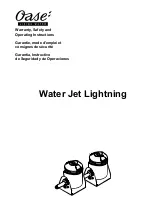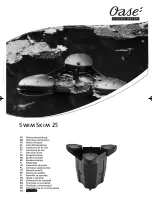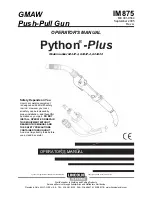
SAFETY INSTRUCTIONS
4
CITOARC AP 217/ AP 225
a) Connecting the welding/cutting current sources to the mains
a.1)
Before connecting your equipment, you must check that:
the meter, the protection device against excess currents and short-circuits, the connector sockets and plugs of the outlets and
electric installation are compatible with its maximum power and its supply voltage (see the constructor's nameplates), and comply
with applicable standards and regulations;
a.2)
Connection, single-phase or three-phase with ground, is carried out via the protection of a differential-residual current device with
medium or high sensitivity (differential circuit-breaker; sensitivity between 1 A and 30 mA ):
if the wire is connected to a fixed station, the ground, if there is one, must never be cut off from electric shocks by the protection
device;
its switch, if there is one, is on the "OFF" position;
the power-supply cable , if it is not supplied, must be of the "HAR USE" type;
your electric power-supply circuit must be equipped with an emergency shutdown device, which is easy to recognize and positioned
so as to be easily and quickly accessible.
b) Work-station
Implementation of arc welding and cutting implies strict compliance with safety conditions with respect to electric currents.
Make sure that no metallic part accessible to operators and their assistants can come into direct or indirect contact with a live wire or the
neutral of the power-supply network.
Use only electrode holders and torches which are perfectly insulated.
The operator must be insulated from the ground-surface and the workpiece (gloves, safety shoes, dry clothes, leather apron, and so
forth...).
Connect the ground conductor to the part as close as possible to the welding area and in a secure manner (this is in order to ensure good
current flow).
Do not touch the electrode wire and the part (or the nozzle) simultaneously.
When welding work has to be carried out outside the usual and normal working conditions with increased risk of electric shock (for
example: enclosure in which the operator finds it difficult to maneuver) additional safety precautions must be taken, particularly:
Ö
the use of a welding/cutting current source marked
Ö
reinforcing of individual protection.
c) Maintenance / Troubleshooting
Before any internal verifications and repair work, make sure that the equipment is separated from the electric installation by electrical
isolation (by electrical isolation is meant a group of operations designed to separate and keep the equipment de-energized).
Some equipment has a HV.HF striking circuit (indicated by a plate).
You must never work or perform servicing operations on this
circuit
(contact OERLIKON for all servicing operations).
At least every six months, you must check the proper condition of the insulation and connections of the electric equipment and accessories
such as plugs, flexible wires, ducts, connectors, extension leads, part-holders, electrode-holders, or torches...
Maintenance and repair work on the jackets and insulating ducts must be carried out extremely carefully.
Have defective parts repaired by a specialist, or better still, have them replaced.
Routinely check the proper tightening and cleanliness of the electric connections.
See the MAINTENANCE section below, dealing in particular with maintenance and troubleshooting on your equipment.
2. PROTECTION FROM SMOKE, VAPORS, HARMFUL AND
TOXIC GASES
Welding and cutting operations must be carried out in areas which are suitably ventilated.
Emissions in the form of gas or fumes which are harmful, disturbing or dangerous for the health of workers, must be collected progressively
as they are produced, and as close to their source of emission and as efficiently as possible.
(Art. R232-1-7 Decree 84-1093 dated
December 7
th
1984)
.
Smoke sensors must be linked to a suction system so that any possible concentrations of pollutants do not exceed the limit values.
We would recommend that you consult the "
Practical Ventilation Guidelines n°7 - ED 668
", arc welding operation, National Institute of
Research and Safety (INRS), in which are given the calculation methods and various practical application examples.
OERLIKON proposes an entire range of suction systems corresponding to your needs.
Special case of chlorinated solvents (used for cleaning or grease-removal):
Ö
vapors from these solvents, subjected to radiation from an arc, even a remote one, can, in certain cases, be transformed into toxic
gases. Check that the workpieces are dry.
Ö
when they are not in an impermeable enclosure, the use of these solvents is to be prohibited in an area where there is electric arc jump.
Summary of Contents for citoarc AP 217
Page 4: ...2 CITOARC AP 217 AP 225 ...
Page 15: ...B STARTING UP CITOARC AP 217 AP 225 B 13 ...
Page 19: ...C INSTRUCTIONS FOR USE CITOARC AP 217 AP 225 C 17 ...
Page 24: ...D MAINTENANCE D 22 CITOARC AP 217 AP 225 4 ELECTRICAL DIAGRAMS See diagram opposite ...
Page 25: ...D MAINTENANCE CITOARC AP 217 AP 225 D 23 5 INSTALLATION OF COMPONENTS ...







































